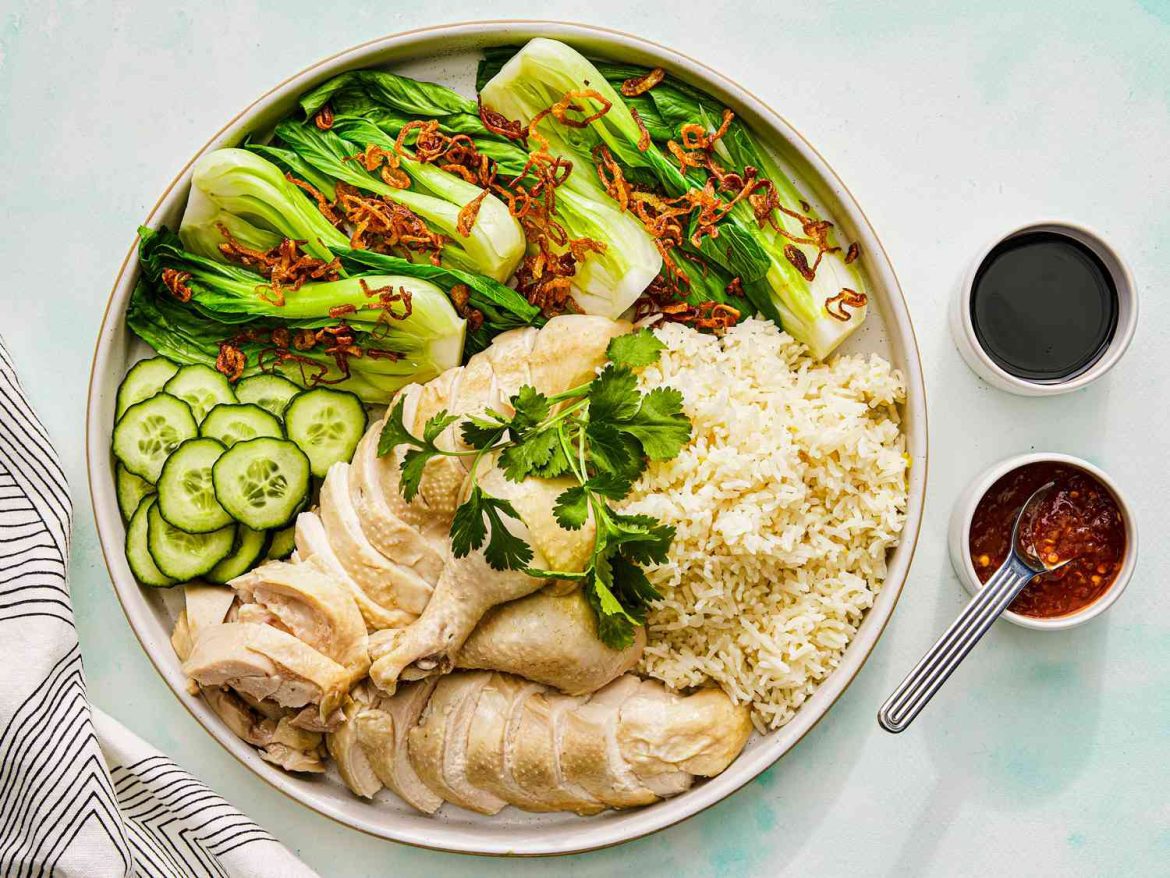You’re about to discover the authentic flavors of Singapore’s national dish, Hainanese chicken rice. This beloved classic originated from Hainan, China, and evolved through cultural exchange with Singapore. To master this dish, you’ll need to poach tender and juicy chicken using precise temperature control and cooking techniques. Next, combine fragrant rice cooked in chicken stock and fat with ginger and pandan leaves, and serve with three signature dipping sauces. As you explore the art of Hainanese chicken rice, you’ll uncover a world of flavors and nuances waiting to be refined.
Key Takeaways
- Hainanese Chicken Rice is a classic Singaporean dish originated from skilled chefs of Hainan, China, blending Hainanese cuisine and Chinese influences.
- Poaching technique is crucial for tender and juicy chicken, requiring temperature control and 20-25 minutes cooking time for a 3-4 pound chicken.
- Fragrant rice cooked in chicken stock and fat with ginger and pandan leaves is a signature component of the dish.
- Three dipping sauces, Ginger-Garlic, Sweet Dark Soy are essential for the complete flavor experience of Hainanese Chicken Rice.
- Mastering the signature sauces and experimenting with ingredients can unlock a world of flavor possibilities for this classic dish.
Origins of Hainan Chicken Rice
Origins of Hainan Chicken Rice
Hainan Chicken Rice originated from the skilled chefs of Hainan, China, who brought their culinary expertise to Singapore, making it the national dish.
The Fusion of Flavors
The dish is a unique blend of Hainanese cuisine and Chinese culinary influences. This fusion resulted in a flavor profile that sets Hainan Chicken Rice apart from other Asian dishes.
The dish is balanced, with:
- Richness of chicken fat-infused rice
- Brightness of fresh scallions and ginger
A Reflection of Cultural Exchange
Hainanese chefs adapted their culinary traditions to their new surroundings in Singapore. This cultural exchange resulted in a dish that reflects both its Chinese roots and Singaporean classic.
Preparing the Perfect Chicken
Poaching the Perfect Chicken
To get tender and juicy chicken, you need to poach it correctly. This involves careful attention to temperature and timing.
Temperature Control
- Bring the water to a boil, then reduce the heat to a simmer.
- Keep the water temperature between 160°F and 170°F.
This temperature control is crucial, as it allows the chicken to cook slowly and evenly.
Cooking Time
- Cook the chicken for about 20-25 minutes for a 3-4 pound chicken.
- Monitor the cooking time carefully to get the best results.
Avoid Overcrowding
- Don’t overcrowd the pot, as this can lead to uneven cooking and a less desirable texture.
- Cook the chicken alone, allowing it to absorb the flavorful broth.
By following these steps, you’ll get a chicken that’s not only tender but also packed with flavor.
This technique is essential to achieve the full potential of your Hainanese chicken rice, with a flavor profile that’s both rich and refined.

The Signature Flavors Unite
Bringing it All Together: The Signature Flavors of Hainanese Chicken Rice
Now that your chicken is perfectly poached and cooled, it’s time to unite the signature flavors that make Hainanese chicken rice a culinary sensation.
The Essential Components
- Fragrant rice cooked in chicken stock and fat, infused with ginger and pandan leaves
- Tender and juicy chicken, cooled to perfection to lock in the flavors
- Three signature dipping sauces:
- Spicy chili sauce
- Savory sweet soy sauce
- Aromatic ginger-garlic sauce
- Fresh scallions and ginger, adding a pop of color and freshness
- A sprinkle of salt, enhancing the flavors and textures of the dish
The Magic of Hainanese Chicken Rice
As you bring these signature flavors together, you’ll experience the magic of Hainanese chicken rice. The combination of these components will transport your taste buds to the streets of Singapore, where this dish is a beloved national treasure.
Mastering the Recipes and Sauces
Mastering the Recipes and Sauces
To make authentic Hainanese chicken rice, you need to master three signature sauces. These sauces are crucial to the dish, and perfecting them requires attention to detail and experimentation.
Three Signature Sauces
- Ginger-Garlic Sauce
- Sweet Dark Soy Sauce
- Chili Sauce
Tips to Master the Sauces
- Experiment with different ingredients to create unique flavor combinations.
- Try substituting ingredients to change the flavor profile. For example:
- Replace ginger with galangal in the Ginger-Garlic Sauce for a stronger flavor.
- Use different types of sugar in the Sweet Dark Soy Sauce to alter the sweetness level.
- Practice cooking techniques like simmering and reducing to achieve the perfect balance of flavors.
Get Creative with Flavor Combinations
Don’t be afraid to think outside the box and try new flavor combinations. By mastering these sauces, you’ll discover a world of flavor possibilities that will take your Hainanese chicken rice to the next level.
Nutrition and Related Delights
Hainanese Chicken Rice: A Flavorful and Balanced Meal
Hainanese chicken rice is a dish that’s packed with flavor and nutrients. A single serving contains 741 calories, which is relatively moderate. This makes it a healthy option for those who want to indulge in a flavorful meal without consuming too many calories.
Nutritional Breakdown
- Carbohydrates: 88g
- Protein: 33g
- Fat: 27g
Make It Even Healthier
You can make Hainanese chicken rice even healthier by substituting some ingredients with lower-calorie alternatives or reducing the amount of oil used in the recipe.
Other Delicious Options to Explore
- Fusion cuisine variations, like Korean-style Hainanese chicken rice with spicy Gochujang sauce
- International variations, such as Japanese Oyakodon or Vietnamese Chicken & Rice Noodle Salad
- Culinary trends, like using plant-based proteins or vegan sauces to make the dish more accessible
- Healthy twists, like using brown rice or reducing the amount of added salt
- Global inspirations, like adding Indian spices or Middle Eastern flair to the dish
